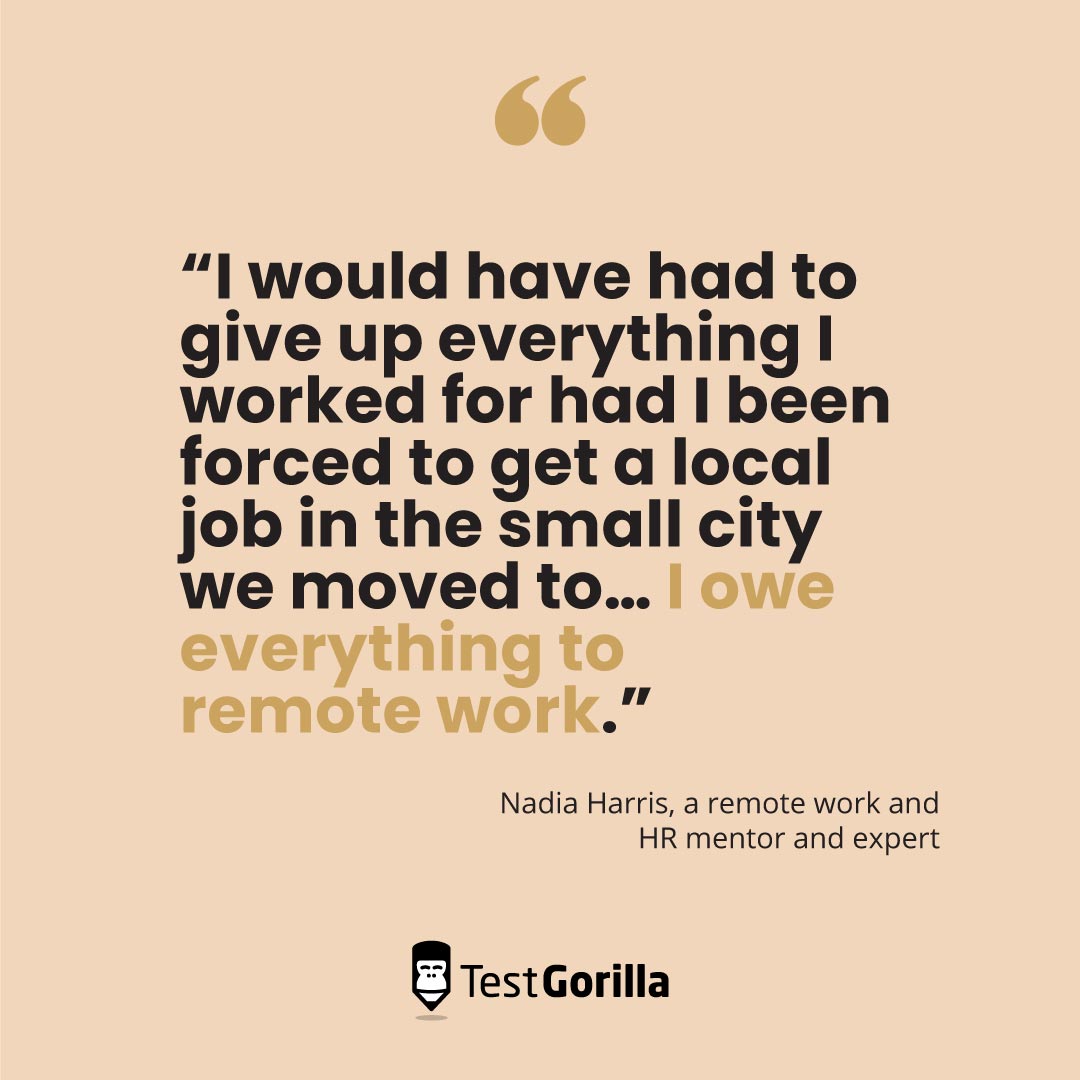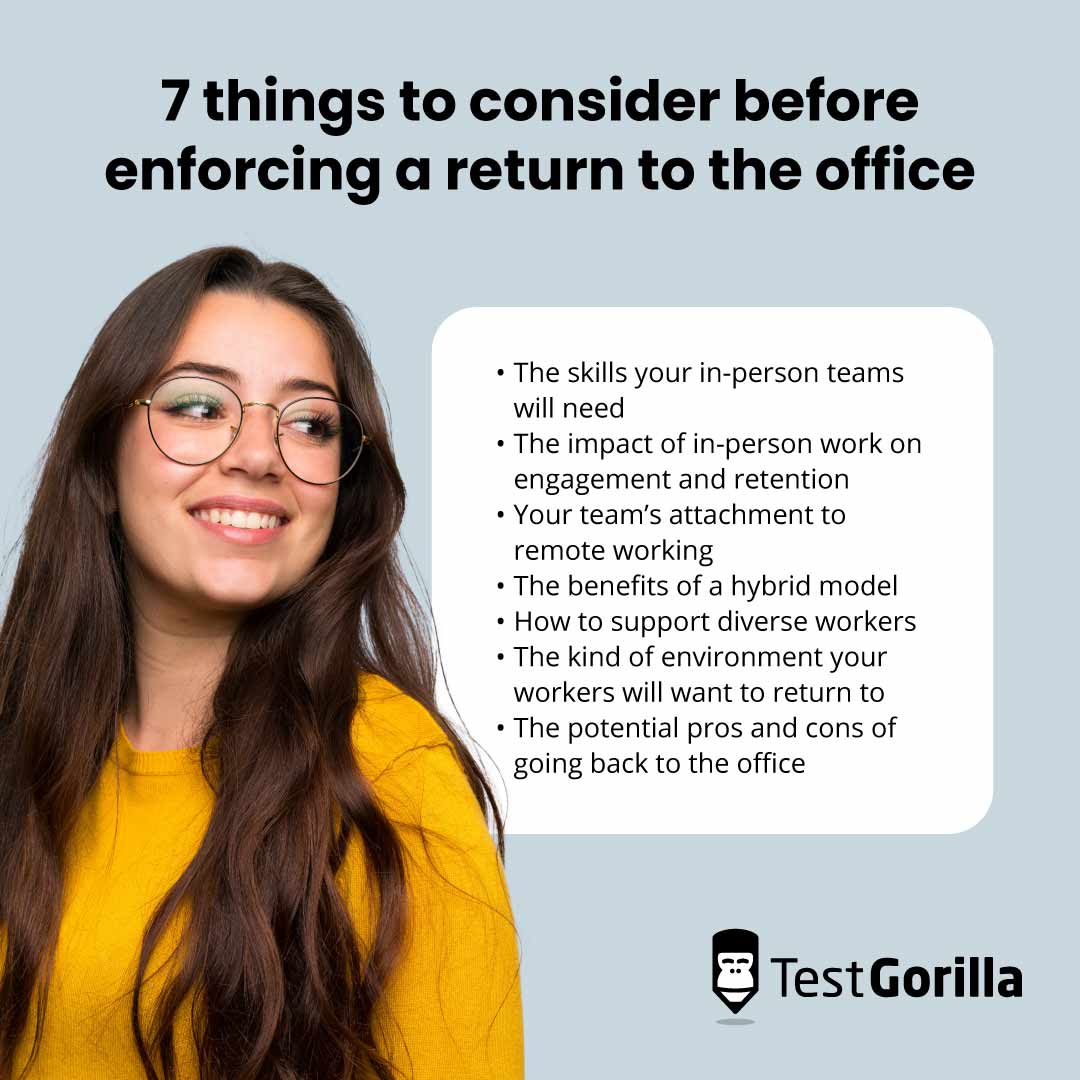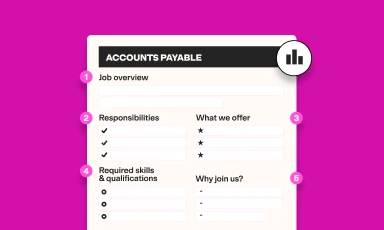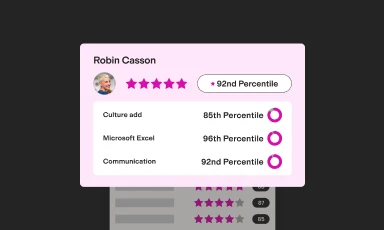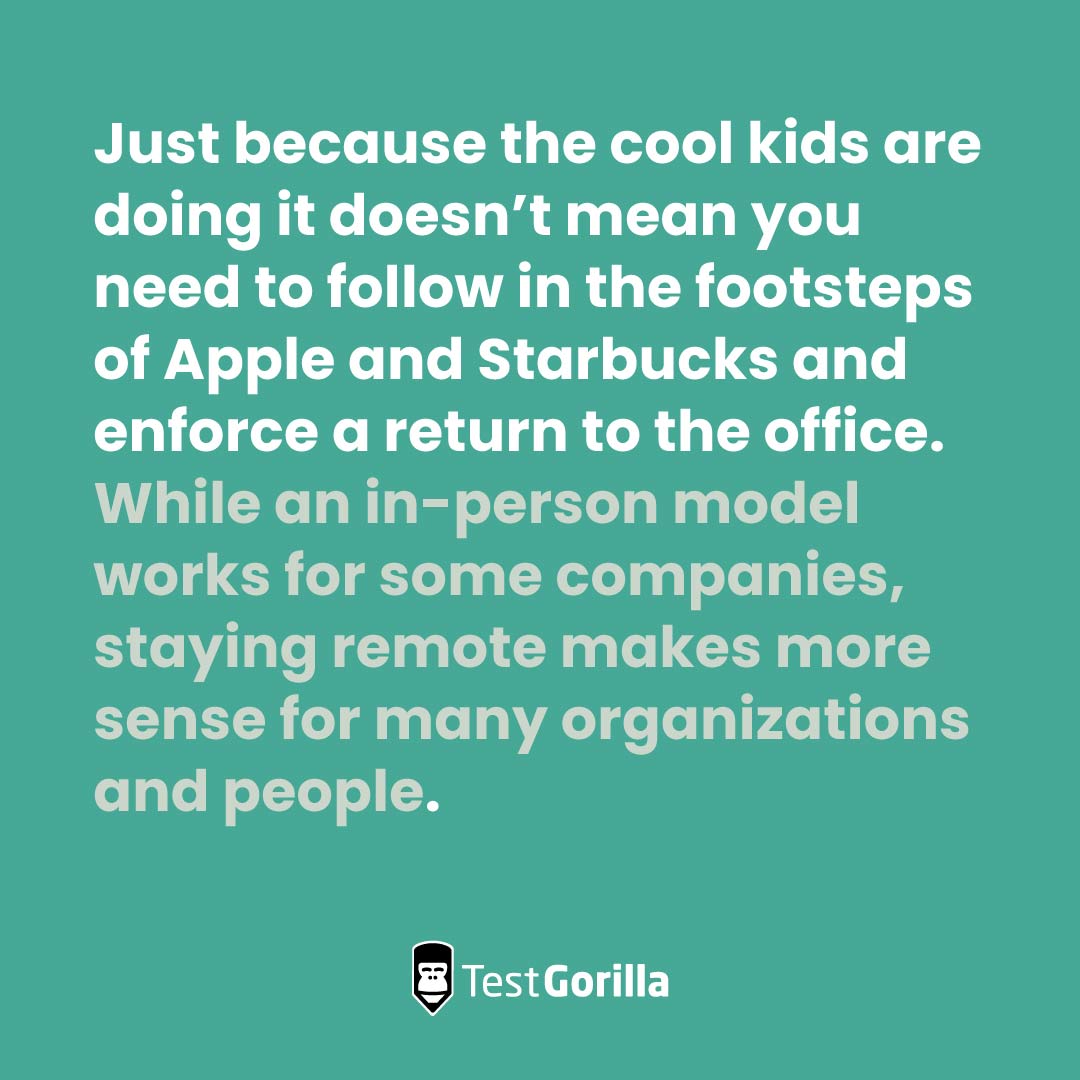Thinking of enforcing a return to the office? Consider these 7 things before making a decision
Apple, Dell, Disney, and Starbucks. These aren’t just Fortune 500 companies, but large corporations that are telling their employees to get back to the office.
However, just because industry giants are doing it doesn’t necessarily mean it’s the right move for your organization. Unless you have a solid reason for doing so, requiring employees to go back to the office may not be in everyone’s interests.
That’s why before mandating a shift to in-person work, it’s important to consider the benefits of remote work as well as the steps you should take to ensure a successful in-person model. In this article, we’ll walk you through seven things to consider before asking everyone to come to the office.
Table of contents
How remote work opened up a world of opportunities
Nadia Harris, a remote work and HR mentor and expert, moved to the United States from Europe around 2015, where she found a remote freelance role. This meant she was able to keep her job when she had to move back to Europe a year later for her husband’s job.
When she decided she wanted to do an MBA at a US university a few years later, she was able to study remotely from Europe thanks to the program’s hybrid format. Remote work gave Nadia the freedom to grow without having to choose between her relationship and career, and these experiences led her to eventually found Remote Work Advocate.
She says that without those remote opportunities, she would have had to make some real sacrifices. “I would have had to give up everything I worked for had I been forced to get a local job in the small city we moved to… I owe everything to remote work.”
Remote work has benefited employees
Nadia is just one of the countless examples of how remote work has changed people’s lives. Think about caregivers who can assist their aging parents, new parents who are able to spend more time with their young children, and people with disabilities who can now work in roles that were previously not accessible to them.
Nadia also emphasizes the opportunities remote work has created for immigrants, who in many cases are well-educated individuals who move to other countries looking for a better life. Upon arrival, they are often forced to work low-paying jobs they are overqualified for.
Remote work means this no longer has to be the case. For example, a computer engineer from Venezuela can move to Spain, where there are more visa options, while working for a UK-based software company with higher salaries than a Spanish or Venezuelan one.
Companies also win with remote work
Remote work has also created a wealth of opportunities for companies, who are no longer limited to hiring talent from a specific geographic location but can now recruit top talent from across the world.
Additionally, if a company wants to expand into a new market, they no longer have to open offices abroad. Instead, remote work allows them to hire employees from that country while keeping overhead low.
Even so, some companies are thinking about taking things back to the way they were before.
7 things to consider before enforcing a return to the office
If you’re considering a return to in-person work, weigh these seven factors to ensure you’re making the right choice for your organization and your people.
1. The skills your in-person teams will need
Especially if you’ve built your team remotely, your people may not possess some of the characteristics that are essential to working in person, like face-to-face team management, mentoring, or public speaking during client presentations.
You can check whether existing team members have the skills they need to thrive in person with skills assessments. For example, TestGorilla offers assessments on communication, negotiation, and leadership skills, all of which can help you gauge whether your team members have the competencies they need to work well in a traditional office setting.
If your employees’ soft skills need work, you can then use microlearning tactics to fill in skills gaps and give them the support needed to successfully return to in-person work.
2. The impact of in-person work on engagement and retention
Productivity isn’t the only thing you should take into account when deciding whether to implement a return to the office. Nadia emphasizes that companies too often confuse productivity with timesheets and attendance. In other words, there’s more to the puzzle than employee output when it comes to the remote vs. in-person decision.
With two-thirds of surveyed employers citing employee retention as the main reason for offering remote work, forcing people back to the office could even mean losing key members of your team.
While you may think having everyone in the office is the best way to engage your people, staff with the option of working remotely actually reported higher levels of engagement than employees with no remote option.
When your teams are more engaged, they’re not only more productive, but also more likely to stick around. If an in-person mandate could have a negative impact on employee retention, you may want to reconsider your approach.
3. Your team’s attachment to remote working
Seventy-three percent of employees state they need a better reason to go back to the office than just company expectations. By considering your team’s attachment to remote working before making a decision, you can ensure you’re making the right choice for everyone involved.
Perhaps one of your employees moved out of the city to be closer to their family when we all went remote during the pandemic. Would you be forcing them to move if you made everyone go back to the office?
Even in less extreme cases, people are no longer accustomed to paying to eat out for lunch every day and spending hours on a daily commute. If you don’t give employees the flexibility they’ve come to expect, you shouldn’t be surprised if you see some of them quiet quitting.
While it would be great to accommodate every employee’s needs, sometimes that’s not possible. Nadia emphasizes that “peoples’ opinions matter a lot. Just remember, you have to look at your company as a whole and prioritize the team’s needs over individual needs.”
A great way to balance the needs of the individual and your whole team leads us to our next point: a hybrid model.
4. The benefits of a hybrid model
Nadia defines a hybrid model as “taking the best elements of two or more solutions.” By going hybrid instead of a strictly in-person model, you give your employees the flexibility they want while keeping your talent pool broad, as you can still hire candidates from outside your immediate geographical area.
Going hybrid also means you don’t alienate existing employees, like caregivers, parents, and disabled workers, who rely on working from home to take care of their loved ones and themselves.
To make a hybrid model work, you should:
Use the best elements of both setups. Take key elements from a remote-first model while providing an office experience to enhance employee engagement and collaboration.
Maintain a remote-first mindset. Tailor the experience to the needs of your people and your company. If you’re forcing everyone back to the office three days a week when half your employees will just sit in virtual meetings all day, you need to rethink the model.
Be wary of proximity bias. Managers tend to favor people who are physically close to them, so closely track data on pay and promotions to ensure all your employees are getting fair treatment, regardless of whether they choose to come into the office or stay at home.
5. How to support diverse workers
When talking about the flexibility it offers, remote work is especially valuable to employees with diverse needs and life circumstances.
For example, Meta has noticed that US candidates who have accepted remote job offers are significantly more likely to be Black, Hispanic, Native American, Alaskan Native, Pacific Islander, and/or have disabilities. In terms of their global talent pool, candidates accepting remote offers from Meta were more likely to be women.
If you’re hoping to keep your organization inclusive while requiring your people to go back to the office, you need to go out of your way to support diverse workers. Nadia says: “Consider someone who is in a wheelchair. If you don’t give these individuals this opportunity for remote work and flexibility, it’s almost as if you’re saying ‘if you’re disabled, you don’t deserve a job.’”
By considering how to support diverse employees, parents, caregivers, and people with disabilities as they return to the office, you can ensure they still have a positive and supportive work experience.
This may look like flexible working hours or childcare support, or even a hybrid model that lets employees design the schedule that best fits their situation.
“The return to the office may be challenging for some employees. Offer support, such as mental health resources, counseling services, or flexible work hours, to help them adjust to the change. An inclusive work environment where employees feel comfortable expressing their concerns and needs is what you want to have — without that there’s no way to make that transition smooth.”
Aristida Marakauskaité, HR business partner at RatePunk
6. The kind of environment your workers will want to return to
Full-time office workers report lower levels of work-life balance and satisfaction with their working environment. It’s therefore worth taking extra care to create conditions that accommodate your employees if you’re having them go back to the office.
Consider the unique working and communication styles among your employees. With night owls, early birds, introverts, and extroverts making up your team, people have a lot more freedom at home over how they choose to work.
Here are a few things to keep in mind:
Allowing for flexible hours is key to maintaining levels of employee satisfaction.
With IRL fatigue replacing Zoom fatigue, create a physical space that gives your employees privacy and a break from social interactions if they need it.
Be sure your office is easy to access and navigate to accommodate disabled workers, and design your office for neurodiversity by favoring natural and soft lighting and outfitting your space with comfortable seating options.
Finally, while donuts in the break room can’t make up for the flexibility remote work offers, perks like an espresso machine or a lunch stipend are the little details that can boost employees’ moods when they’re back in the office.
7. The potential pros and cons of going back to the office
Idealizing the thought of sending your employees back to the office doesn’t guarantee it will turn out as you expect it to. Nadia suggests “all companies that want to go back to the office perform a SWOT analysis to identify the strengths, weaknesses, opportunities, and threats of doing so.”
Before mandating an in-person policy across the board, ask yourself a few questions:
What are our team’s responsibilities?
What do our employees’ day-to-day schedules look like?
How do we track success rates and productivity?
Weighing the risks and benefits of sending people back to the office will help you make a more calculated decision. Additionally, keeping a close eye on productivity will help you understand whether your decision has had a positive impact on employee output.
The best insights on HR and recruitment, delivered to your inbox.
Biweekly updates. No spam. Unsubscribe any time.
A return to the office shouldn’t mean a return to traditional ways of hiring
When companies went remote, they were forced to experiment with finding new ways to recruit, like skills-based hiring and recruiting from a global talent pool. All this has helped level the playing field while providing numerous business benefits.
Despite considering a return to a traditional working environment, there’s no reason to go back to traditional ways of hiring, like in-person interviews or biased recommendations.
Instead, use skills-based hiring to help you:
Recruit without bias
Access the best talent for your open roles
Enjoy the benefits of a diverse workforce
Hiring managers can source candidates for in-house or hybrid teams by incorporating skills-based hiring into their recruitment process. This in turn lowers skills gaps and ensures people are equipped with the abilities they need to succeed in their roles.
Whether you stay remote or go back to the office, do it for the right reasons
Just because the cool kids are doing it doesn’t mean you need to follow in the footsteps of Apple and Starbucks and enforce a return to the office. While an in-person model works for some companies, staying remote makes more sense for many organizations and people.
If you do decide to switch from a remote model to an in-person setup, think through considerations like:
The needs of your team
How your people feel about going back to the office
Whether a hybrid model could be a better solution
This will ensure your decision doesn’t have a negative impact on employee engagement, satisfaction, and retention.
Additionally, avoid a return to traditional and biased hiring practices by using skills-based hiring to recruit a diverse group of candidates from the widest talent pool.
Skills-based hiring: The optimal hiring process for any team
Skills-based hiring helps remote, hybrid, and in-person companies find the best people for their roles. Learn more in the 2022 State of Skills-Based Hiring Report.
You've scrolled this far
Why not try TestGorilla for free, and see what happens when you put skills first.


